Hans Danuser
Hans Danuser (born in 1953 in Chur) is a Swiss artist and photographer.[1] His first mayor work, the cycle In Vivo, brought him international fame, therein he broke several societal taboos with respect to genetic research and nuclear physics.[1] Since the 1990s, in addition to his photographic studies, Danuser has focused increasingly on transdisciplinary (research) projects in the arts and sciences.[2][3]
Oeuvre
Hans Danusers work is regularly showcased in important solo and group exhibitions at home and abroad. He has been invited to contribute to international events such as the biennales in Venice and Lyon.[2] He is one of the first photographer to have taken the conceptually compelling step of presenting his large-format tableaux on the floor in a museum exhibition.[4] In the 1980s Danuser embarked on his cycle In Vivo, completing it in 1989.[1] Contemporaneously he produced architectural photographs in the project Partituren und Bilder/Scores and Pictures. In 1990 Danuser won the competition for the large-scale design of the walls at the University of Zurich-Irchel, which led to the Institutsbilder (1992).[1][2] He later completed another important project in an architectural context, the Schiefertafel Beverin (2000–2001).[5] The Frozen Embryo Series, made in 1990s, a follow-up of In Vivo, also prefigured two ongoing works, The Erosion Project and Entscheidungsfindung – Decision taking.[6]
Biography
After working in Zurich for the German advertising and fashion photographer Michael Lieb from 1972–1974, Danuser began experimenting with light-sensitive emulsion at the ETHZ Federal Institute of Technology Zurich.[1] 1979–1989: work on the cycle In Vivo. 1980s and 1990s: working in Zurich and New York. 1986: Artist in residence in Los Alamos. Since the 1990s: large-format series of photographs as installations in space and transdisciplinary projects in the arts and sciences.[1] Spring 2009: first Visiting Artist at the Centre for Studies in the Theory and History of Photography at the Institute of Art History of the University of Zurich and subsequently visiting professor at the ETH Zurich. Hans Danuser is primarily based in Zurich.[3][7]
Series and projects
Entscheidungsfindung – Decision taking
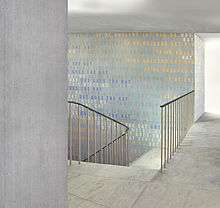
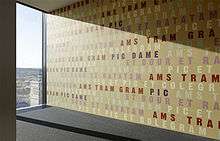
The Counting Out Rhymes project on the subject of Entscheidungsfindung – Decision taking (work in progress) involves video stations and art-in-architecture. Danuser is interested in the approaches and models used in taking decisions as a social and political instrument, ranging from mathematical theory to the practical counting-out rhymes of children.[6] The rhymes – “a mixtum compositum of reason and imagination”[8] – are as significant as mathematical formulae and physical laws inasmuch as they are grounded in “nonrational processes of taking decisions”[9] and therefore reflect the fundamental structure of contemporary models of thought.
- Joggeli (Nationale Suisse, Basel, 2014)
- Akka Bakka (Zurich Department of Health, 2013)
- Piff Paff Puff (Prime Tower, 2010–2012)
- Insert-Du (2009)
- Video installation (since 2008)
Previous work
- Wildwechsel (1993)
The Erosion Project
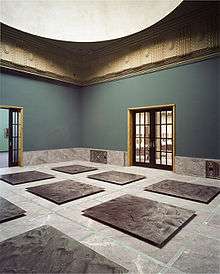
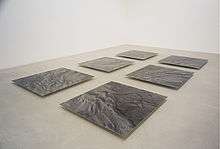
The Erosion Project (work in progress) conducts research into the erosion of natural and cultivated landscapes which takes the shape of a clear, reduced aesthetic. 'The project consists of three series: floor installations, Erosion I-VII (2000-2006); Modeling Erosion (2003-2007), created in collaboration with the ETH Zurich Institute of Geotechnical Engineering; and Landschaft in Bewegung/Moving Landscape (2008-), a collaboration with the ETHZ Laboratory of Inorganic Chemistry as part of the research project Farbe und Fotografie/Colour and Photography. Earlier works were seminal to the series, specifically Landschaften (1993-1996) and the art-in-architecture project Schiefertafel Beverin (2001).
- Erosion I-VII (2000–2006)
- Modeling Erosion (2003–2007)
- Landschaft in Bewegung/Moving Landscape (seit 2008)
Previous work
- Landschaften (1993–1996)
- Strangled Bodies (1995, 2001)
- Schiefertafel Beverin (2000–2001)
Frozen Embryo Series
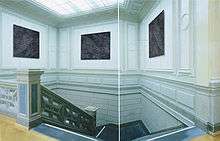
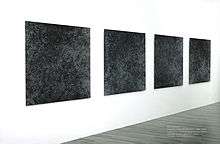
The photographs in the Frozen Embryo Series (1996–2000) have their origins in medical laboratories and gene research. These works find Hans Danuser playing with the opportunities presented by analogue photography: he takes a single negative (which he calls the “original”) and, by turning and mirroring it in the darkroom, generates from it a number of other images, which he calls “one-offs”. To reinforce this impression, Hans Danuser chose the square as format for his images, slightly stretched to 140 cm x 150 cm. The Frozen Embryo Series was first shown at the Kunsthaus Zurich in 1996. Günter Metken writes in the exhibition catalogue: “Without being explicit, Hans Danuser's work addresses the classical problem – and paradox – of painting: the perception of nature and its reproduction, the tension between surface and depth, volume and two-dimensionality, foreground and background, microscopy and totality, vision and the sense of touch. The artist actualises these issues and yet his stream of drifting shapes reminds us of Monet's Water Lilies. Our gaze wanders, roams, follows winding shapes in an ecstasy of sensual expansion and refinement.”[10]
- Frozen-Embryo-Installation (1996)
Scores and Pictures
1988 found Hans Danuser for the first time showing the pictures in the Architekturgalerie Luzern under the title Partituren und Bilder (Scores and Pictures), which he had been commissioned to photograph by the Pritzker prizewinning architect Peter Zumthor in 1986–1988: the Atelier des Architekten (Architect's studio) in Haldenstein, the Schutzbauten über römischen Funden (protective pavilions above Roman finds) in Chur and the Kapelle Sogn Benedetg (Chapel of St. Benedict) in the Surselva region of Canton Graubünden. The artist-cum-photographer was given carte blanche by the architect. In his essay in the book Zumthor sehen. Bilder von Hans Danuser – Nachdenken über Architektur und Fotografie, Philip Ursprung, professor of contemporary art and architectural history, discusses the impact that Danuser's photographs in Partituren und Bilder exerted on the depiction of architecture in photography: “With his photographs of Sogn Benedetg, Danuser radically altered the conventions of architectural photography. Instead of neutral documentation, he was interested in personal interpretation. And instead of reducing the phenomenon to a photograph, he as it were dismantled the building into its component parts, like a short film, which breaks the subject down into sequences and shows it from different perspectives; today one would call this performative. These fragments offer the observer the opportunity to reconstruct the building in the imagination.”[11]
- Partituren und Bilder. Architektonische Arbeiten aus dem Atelier Peter Zumthor (1985–1988) (Score and Pictures. Architectural work from the studio of Peter Zumthor)
- Peter Zumthor, Therme Vals, in Zusammenarbeit mit Fritz Hauser, Sounding Stones Therme Vals (1996) (Peter Zumthor, Vals Thermal Baths, in collaboration with Fritz Hauser, Sounding Stones Vals Thermal Baths)
- Zumthor sehen. Bilder von Hans Danuser (2009) (Looking at Zumthor, Pictures by Hans Danuser)
In Vivo
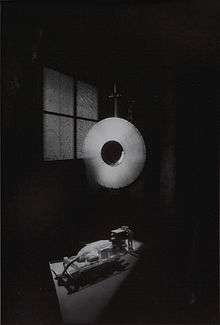
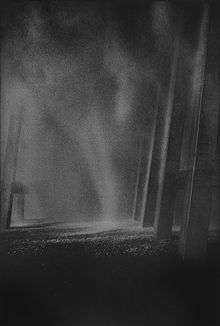
Danuser worked for ten years on seven series of images, which he compiled in 1989 under the title In Vivo and presented to the public for the first time at the Kunstmuseum Aarau; the exhibition was curated by Beat Wismer. Taken in Europe and the USA, the photographs in In Vivo are arranged in seven sections: A-Energie, Medizin I, Gold, Medizin II, Chemie I, Los Alamos, Chemie II (Nuclear Energy, Medicine I, Gold, Medicine II, Chemistry I, Los Alamos, Chemistry II). Depicting a variety of workplaces in research and production facilities, the work affords insights into taboo areas of late-industrial Western society without showing the people themselves. The images gauge the ambivalence of photography between documentation and fiction. The work has appeared in a book published by Lars Müller in 1989, also titled In Vivo.[1]
- In Vivo (1980–1989), 93 black-and-white photographs
Publications
Selected publications and artist books / primary literature
- Bündner Kunstmuseum Chur (ed.), Hans Danuser - Drei Fotoserien Chur: Bündner Kunstmuseum 1985.
- Hans Danuser, Partituren und Bilder. Architektonische Arbeiten aus dem Atelier Peter Zumthor 1985-1988. (Publication accompanied eponymous exhibition, Architekturgalerie Luzern 2–23 October 1988, Haus der Architektur Graz, 27 July-18 August 1989). Lucerne: Architekturgalerie, 1988
- Aargauer Kunsthaus (ed.), Hans Danuser - In Vivo - 93 Fotografien. In Vivo. Baden: Lars Müller, 1989
- Bündner Kunstmuseum Chur (ed.), Hans Danuser. Wildwechsel. Baden: Lars Müller 1993.
- Reto Hänny, Helldunkel. Ein Bilderbuch. Frankfurt: Suhrkamp, 1994
- Delta. Fotografien 1990-1996. (Publication accompanied eponymous exhibition: Kunsthaus Zurich: 12 April–23 June 1996). Baden: Lars Müller, 1996
- Nidwaldner Museum et al. (eds.), Hans Danuser. AT (accompanied exhibition, Im Höfli, Stans, 26 October–21 December 1997), Stans, 1997.
- Hans Danuser (photography) and Urs Stahel (text), Frost. (supplement to publication accompanying the eponymous exhibition, Fotomuseum Winterthur: 9 November 2001 – 6 January 2002). Zurich: Scalo, 2001.
- Hartmut Böhme in conversation with Hans Danuser, Die Oberflächen sind niemals stabil. In: Die neue Sichtbarkeit des Todes. eds. Thomas Macho and Kristin Marek, Berlin, with image documentation on Hans Danuser's In Vivo, Frozen Embryo Series, Strangled Body, Erosion. Munich: Wilhelm Fink, 2008 pp. 239–273.
- Flurina Paravicini et al. (eds.), Hans Danuser – The Counting Out Rhymes Project über Entscheidungs Findung / Decision Taking, with texts by Ursula Pia Jauch and Beat Stutzer and a screen print insert by Hans Danuser. Lucerne: Periferia, 2008.
- Hans Danuser, Entscheidungsfindung, with texts by Stefan Zweifel, Gerd Folkers and Stefan Kaiser and a conversation between the artist and Andrew D. Barbour. In: DU – Periodical for Art and Culture, issue 795/April 2009, pp. 80–107.
- Zumthor sehen. Bilder von Hans Danuser, with an essay by Philip Ursprung and a conversation between Köbi Gantenbein and Hans Danuser. Zurich: Hochparterre bei Scheidegger & Spiess, 2009.
- Hans Danuser, Erosion und Landschaft in Bewegung, with a conversation between Christian Kerez and Hans Danuser. In: trans 20, 2012, gta, Zurich.
- Wulf Rössler, Hans Danuser (eds.), Burg aus Holz – das Burghölzli. Von der Irrenheilanstalt zur Psychiatrischen Universitätsklinik Zürich. Entwicklungen, Innen- und Aussensichten. NZZ Libro, Zurich 2013, ISBN 978-3-03823-739-6.
- Hans Danuser, Bettina Gockel (eds.), Die Neuerfindung der Fotografie. Hans Danuser – Gespräche, Materialien, Analysen (Studies in Theory and History of Photography 4). Berlin/Boston: De Gruyter 2014.
Selected secondary literature
- Urs Stahel and Guido Magnaguagno, Neue Schweizer Photographen. In: DU – Periodical for Art and Culture 8, 1985, Zurich, pp. 24–67.
- Günter Metken: Die Bilder der Dinge: Die von der Oberfläche der Körper wie Häutchen sich schälen. In: Hans Danuser – Delta. (Publication accompanied eponymous exhibition: Kunsthaus Zurich: 12 April–23 June 1996). Baden: Lars Müller, 1996.
- Thilo König: Hans Danuser – ‘Frost’. In: Kunstforum International no. 159 (April–May) 2002, pp. 416–417.
- Beat Stutzer, Schärfe und Beharrlichkeit – zu den Bildern von Hans Danuser. In: Bündner Jahrbuch 2003. Chur: 2003.
- Suzann-Viola Renninger: Ene, mene, mei. Der Künstler Hans Danuser. In: Schweizer Monatshefte. Periodical for politics, business and culture, issue 01/02, January/February 2007, p. 4
- Gisela Kuoni, Hans Danuser ‘Auszählen – The Counting Out Rhymes Project’. In: Kunstbulletin, 11/2008, Zurich, pp. 72–73.
- Marco Baschera, Von der vorzeitlichen Präsenz eine Platzes. In: Präsenzerfahrung in Literatur und Kunst / Beiträge zu einem Schlüsselbegriff der ästhetischen und poetologischen Diskussion. With a picture insert on Hans Danuser – Schiefertafel Beverin. Munich: Wilhelm Fink 2008, pp. 75–100.
Exhibitions
Selected solo exhibitions
- 1985: Kunstmuseum Graubünden, Chur (“Drei Fotoserien“)
- 1986: Gewerbemuseum Basel (“Drei Fotoserien“)
- 1986: Photoforum PasquArt, Biel
- 1988: Architekturgalerie, Lucerne (“Partituren und Bilder. Architektonische Arbeiten aus dem Atelier Peter Zumthor 1985-1988“)
- 1989: Aargauer Kunsthaus, Aarau (“In Vivo“)
- 1990: Curt Marcus Gallery, New York (“Photographs“)
- 1991: Städtische Galerie im Lenbachhaus, Munich (“In Vivo“)
- 1993: Bündner Kunstmuseum, Chur (“Wildwechsel“)
- 1996: Kunsthaus Zurich, Zurich (“Delta. Photographs 1990-1996“)
- 1998: Kunstmuseum Nidwalden, Stans (“AT“)
- 1999: Walter Merian Haus, Basel (“Nah und Fern“)
- 2001: Fotomuseum Winterthur, Winterthur (“Frost“)
- 2003: Scalo Galerie, New York (“Frozen“)
- 2003: Galerie Luciano Fasciati, Chur (“Modeling Erosion“)
- 2005: Villa Garbald, Castasegna (“Projekt Garbald“)
- 2006: Moscow House of Photography, Big Manesh, Moscow (“Erosion“)
- 2008: Galerie Luciano Fasciati, Chur (“Auszählen – The Counting Out Rhymes Project“)
- 2009: Galerie Luciano Fasciati, Chur (“Nachdenken über Fotografie und Architektur“)
- 2012: Semper Sternwarte, ETH Zurich (“Ein Colloquium der Dinge“)
- 2014: Municipio Bregaglia, Promontogno (“Uccelin gion fond dal mer”)
Selected group exhibitions
- 1982: Städtische Galerie zum Strauhof, Zurich (“Fotografien III”), curated by Helen Bitterli
- 1983: Städtische Galerie im Lenbachhaus, Munich (“Aktuell `83”), curated by Helmut Friedel, Erika Billeter, Armin Zweite, Vitorio Fagone and Dieter Ronte
- 1987: Town of Nuremberg (“Offenes Ende – aktuelle Schweizer Kunst”), Nuremberg/Erlangen
- 1988: Bündner Kunstmuseum, Chur (“Konfrontationen”), curated by Beat Stutzer
- 1990: Museum für Gestaltung, Zurich (“Wichtige Bilder”), curated by Urs Stahel, Martin Heller
- 1991: The New Museum of Contemporary Art, New York (“The Interrupted Life”), curated by Marica Tucker, France Morin and Peter Greenaway
- 1995: Aargauer Kunsthaus Aarau (“Ohne Titel – Eine Sammlung zeitgenössischer Kunst”), curated by Marianne Gerny, Jean Luc Manz, Urs Stahel, Theodora Fischer
- 1995: Venice Biennale, (“L'ame aux corps”/”Identität & Alterität. Formen des Körpers 1895-1995”), curated by Jean Claire
- 1996: Frankfurter Kunstverein/Kunsthalle Schirn, Frankfurt (“Prospekt”), curated by Peter Weiermair
- 1997: Kunsthalle Krems/Aargauer Kunsthaus Aarau (“Die Schwerkraft der Berge 1774-1997”), curated by Beat Wismer, Wolfgang Denk
- 1997: Biennale de Lyon (“l'autre”), curated by Harald Szeemann
- 1998: Fotomuseum Winterthur (“Die Sammlung”), curated by Thomas Seelig
- 1998: Kunsthaus Zurich (“Im Kunstlicht”), Zürich
- 2000: Kunstmuseum Bern (“Eiszeit”), curated by Ralf Beil
- 2000: Art Exit, New York (“Paradise Now”), curated by Marvin Heiferman, Carole Kismaric
- 2003: Neuer Berliner Kunstverein, Berlin; Art Basel, Scalo, Basel; New York University (“Not Neutral”), curated by Urs Stahel
- 2004: International Center of Photography (ICP), New York (“Imagining the Future”), curated by Carol Squiers; ART Basel, Scalo, Basel
- 2005: Musée de l’Elysée, Lausanne (“Das Körperbild”), curated by William A. Eving; Art Basel, Scalo, Basel
- 2006: Swiss Institute, Rome, Museo d’arte moderna, Ascona, CentrePasquArt, Biel (“Photosouisse”), curated by Walter Eggenberger
- 2007: Bündner Kunstmuseum, Chur (“Fleischeslust”), curated by Kathleen Bühler
- 2008: Aargauer Kunsthaus Aarau (“Stilles Leben. Geschichten von stummen Dingen”), Kuratorin Madleina Schuppli
- 2008: Kunstmuseum Bern and Deutsches Hygiene-Museum, Dresden (“Six feet under”), curated by Bernhard Fibicher
- 2009: Bündner Kunstmuseum, Chur (“Vermessen. Strategien zur Erfassung von Raum”), curated by Katharina Ammann
- 2009: Museum van Hedendaagse Kunst, Mechelen (“All That is Solid Melts Into Air”), curated by Roprecht Ghesquière, Edwin Carels, Bart De Baere, Liliane Wachter, Dieter Roelstraete and Grant Watson
- 2010: Zentrum Paul Klee/Kunstmuseum Bern (“Lust und Laster – Die sieben Todsünden von Dürer bis Naumann”), curated by Juri Steiner, Fabienne Eggelhöfer, Mathias Frehner and others
- 2010: Aargauer Kunsthaus Aarau, (“Yesterday will be better”), curated by Madeleine Schuppli and Marianne Wagner
- 2010: Kunstmuseum Bern (“Don't look now – Die Sammlung Gegenwartskunst”), curated by Kathleen Bühler and Isabel Flury
- 2011: Bündner Kunstmuseum, Chur (“Director's Choice. Die andere Jahresausstellung”), curated by Beat Stutzer
- 2011: Helmhaus Zurich (“Kult Aussersihl Zürich – das andere Gesicht”), curated by Simon Maurer
- 2011: Fotostiftung Schweiz, Winterthur (“Schweizer Fotobücher – eine andere Geschichte der Fotografie”), curated by Martin Gasser
- 2012: Aargauer Kunsthaus Aarau,(“La jeunesse est un art – Jubiläum Manor Kunstpreis”), curated by Madeleine Schuppli and Franz Krähenbühl
- 2013: Fotomuseum Winterthur (“Cross Over. Fotografie der Wissenschaft + Wissenschaft der Fotografie”), curated by Thomas Seelig and Christin Müller
- 2013: Swiss Architecture Museum, Basel (“Bildbau. Schweizer Architektur im Fokus der Fotografie”), curated by Hubertus Adam and Elena Kossovskaja
- 2013: Fotomuseum Winterthur (“Concrete. Fotografie und Architektur”), curated by Thomas Seelig and Urs Stahel
- 2013: Bündner Kunstmuseum, Chur (“Ansichtssache, 150 Jahre Architekturfotografie in Graubünden”), curated by Stephan Kunz and Köbi Gantenbein
- 2014: Arte Hotel Bregalia, Promontogno (“Hans Danuser, Uni dui tre quattar”), curated by Luciano Fasciati and Céline Gaillard
- 2015: Fotobiennale Mannheim-Ludwigshafen-Heidelberg “7 Places 7 Precarious Fields”, curated by Urs Stahel
Awards
- 1987: Canton Graubünden Recognition Award for Visual Arts
- 1992: Manor Kunstpreis
- 1996: Conrad Ferdinand Meyer Prize for Young Art
- 2001: Canton Graubünden Culture Prize[12]
Stipends and studio awards
- 1974, 1976, 1983, 1985: Federal art stipend/Swiss Art Award[13]
- 1979, 1983, 1985: Study and work grants from Canton Zurich[14]
- 1985: Art stipend for a residency at the City of Zurich studio in New York
- 1983, 1984, 1985: Art stipend from the City of Zurich
- 1991: Art stipend for a residency at the Landis & Gyr Foundation studio in London
- 1996: Artist in Residence at Los Alamos Laboratories, New Mexico, USA
Film and television
- Michael Hegglin, Der Fotokünstler Hans Danuser und seine Arbeit im öffentlichen Raum. In: 10vor10 on Swiss TV SF DRS, 1993.
- Michael Hegglin, Zeichen im Dunkel - Hans Danuser. In: Swiss TV SF DRS and TV broadcaster 3sat, April 1996.
- Barbara Seiler, Landscape in Movement – in conversation with the artist and photographer Hans Danuser. In: Sternstunde, Swiss TV SF TV, 18 January 2009 and 24 January 2009, video 52 min. 16 secs.: Camera, Christine Munz // Sound, Michael Ryffel // Editor and music Brian Burmann // Director René Baumann // Head of production Rahel Holenstein // SF TV editor, Marion Bornschier, a coproduction by Videoladen Zurich / Sternstunden, Swiss TV SF TV, Zurich // Cinema premiere at Kino Canva as part of the Solothurner Filmtage programme, 2009.
References
- 1 2 3 4 5 6 7 http://www.sikart.ch/KuenstlerInnen.aspx?id=4000221 Author: Ulrich Gerster, 1998, updated 2011.
- 1 2 3 http://www.foto-ch.ch/?a=fotograph&id=20194&lang=de Author: Marc Herren, 20.08.2015.
- 1 2 http://www.collegium.ethz.ch/ueber-uns/collegium-helveticum/personen/hans-danuser/
- ↑ Hartmut Böhme in conversation with Hans Danuser, Die Oberflächen sind niemals stabil. In: Die neue Sichtbarkeit des Todes. eds. Thomas Macho and Kristin Marek, Berlin, with image documentation on Hans Danuser's In Vivo, Frozen Embryo Series, Strangled Body, Erosion. Munich: Wilhelm Fink, 2008 p. 268.
- ↑ Marco Baschera, Von der vorzeitlichen Präsenz eine Platzes. In: Präsenzerfahrung in Literatur und Kunst / Beiträge zu einem Schlüsselbegriff der ästhetischen und poetologischen Diskussion. With a picture insert on Hans Danuser – Schiefertafel Beverin. Munich: Wilhelm Fink 2008, pp. 75–100, esp. 84-85.
- 1 2 Beat Stutzer. Hans Danuser’s Lettered images, in: Flurina Paravicini et al. (eds.), Hans Danuser – The Counting Out Rhymes Project über Entscheidungs Findung / Decision Taking. Lucerne: Periferia, 2008, p. 58-61.
- ↑ Kunsthistorisches Institut, Universität Zürich, Lehrveranstaltungen im Frühjahrssemester 2009. Dr. Carlo Fleischmann-Visiting Artist für Fotografie. Retrieved on 19 October 2015.
- ↑ Ursula Pia Jauch. In: Hans Danuser – The Counting Out Rhymes Project über Entscheidungsfindung / Decision Taking, Lucerne: Periferia, 2008, p. 40
- ↑ Gisela Kuoni, Hans Danuser ‘Auszählen – The Counting Out Rhymes Project’. In: Kunstbulletin, 11/2008, Zurich, p. 72.
- ↑ Günter Metken: Die Bilder der Dinge: Die von der Oberfläche der Körper wie Häutchen sich schälen. In: Delta. Photographs 1990-1996 (publication accompanying the eponymous exhibition: Kunsthaus Zurich: 12 April–23 June 1996). Baden: Lars Müller, 1996.
- ↑ Philip Ursprung, Die Visualisierung des Unsichtbaren. Hans Danuser und Peter Zumthor: Eine Revision. In: Zumthor sehen. Pictures by Hans Danuser, with an essay by Philip Ursprung and a conversation between Köbi Gantenbein and Hans Danuser. Zurich: Hochparterre bei Scheidegger & Spiess, 2009.
- ↑ Fotoszene Graubünden, Prizes (Selection)
- ↑ Federal Office of Culture (ed.), Über Preise lässt sich reden. 100 Jahre Eidgenössischer Wettbewerb für freie Kunst. Zurich: Orell Füssli, 1999.
- ↑ ’’’…, dass sich die Grenzen verwischt haben.’ – Schauplätze und Stränge der Fotografie in Zürich, 1975– 1990’’. In: Hans Danuser, Bettina Gockel (eds.), Die Neuerfindung der Fotografie. Hans Danuser – Gespräche, Materialien, Analysen (Studies in Theory and History of Photography 4). Berlin/Boston: De Gruyter 2014, p. 224, footnote 46
External links
- "Danuser, Hans". SIKART dictionary and database.
- Hans Danuser at the Fotostiftung Schweiz
- Literature by and about Hans Danuser in the German National Library catalogue
- Website von Hans Danuser
- Hans Danuser Piece in Kulturzeit on 3sat, 11 April 1996 (4' 32)